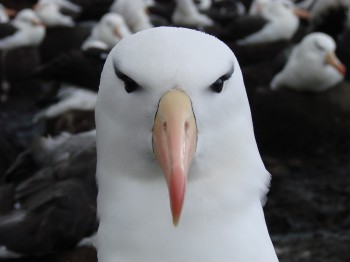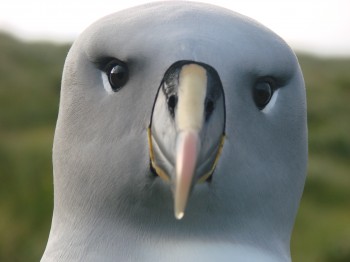Graham Robertson (Kingston, Tasmania, Australia) and colleagues have published in the journal Polar Biology on population increases of Black-browed Thalassarche melanophris and Grey-headed T. chrysostoma Albatrosses on Chilean islands.
Black-browed Albatross
Grey-headed Albatross, photographs by Cristián Suazo
The paper’s abstract follows:
“Black-browed albatrosses (Thalassarche melanophris) are killed incidentally in commercial fishing operations. Aerial surveys in 2002 and 2011 revealed the number of black-browed albatrosses at the Diego Ramírez and Ildefonso islands, Chile, increased by 52 and 18 %, respectively. The increases were attributed to reduced mortality in the longline fishery for Patagonian toothfish (Dissostichus eleginoides) following fleet conversion to a new gear configuration with much higher average hook sink rates. A new survey in 2014 revealed the number of black-browed albatrosses at Ildefonso was about the same as in 2011, but the number at Diego Ramírez had increased by a further 29 % (8.8 %/year). The number of greyheaded albatrosses (Thalassarche chrysostoma) at Diego Ramírez also increased, by 23 %, in the same time period. In 2014, Ildefonso held an estimated 54,284 breeding pairs of black-browed albatrosses. The populations of blackbrowed albatrosses at two more northern sites, the Evangelistas and Leonard islets, stood at 4818 and 545 breeding pairs, respectively. The total number of breeding pairs of both albatross species at Diego could not be determined because not all islands in the archipelago were surveyed.”

Black-browed Albatrosses hunker down on their nests in strong wind on a Chilean Island, photograph by Graham Robertson
With thanks to Cristián Suazo.
Reference:
Robertson, G., Wienecke, B., Suazo, C.G., Lawton, K., Arata, J.A. & Moreno, C. 2016. Continued increase in the number of black-browed albatrosses (Thalassarche melanophris) at Diego Ramírez, Chile. Polar Biology DOI 10.1007/s00300-016-2028-5.
John Cooper, ACAP Information Officer, 05 October 2016

 English
English  Français
Français  Español
Español 
